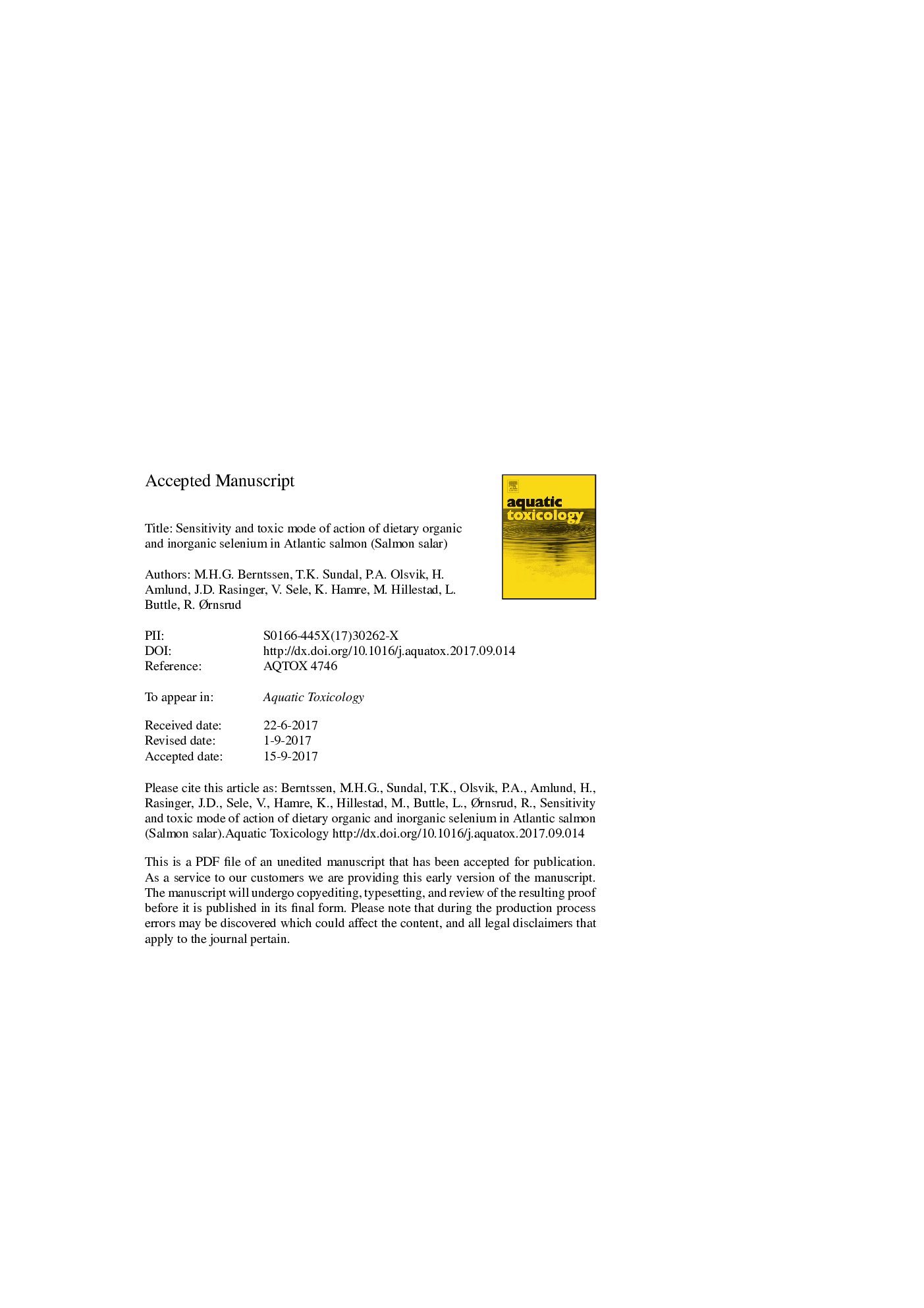| کد مقاله | کد نشریه | سال انتشار | مقاله انگلیسی | نسخه تمام متن |
|---|---|---|---|---|
| 5764129 | 1625913 | 2017 | 45 صفحه PDF | دانلود رایگان |
عنوان انگلیسی مقاله ISI
Sensitivity and toxic mode of action of dietary organic and inorganic selenium in Atlantic salmon (Salmo salar)
دانلود مقاله + سفارش ترجمه
دانلود مقاله ISI انگلیسی
رایگان برای ایرانیان
کلمات کلیدی
موضوعات مرتبط
علوم زیستی و بیوفناوری
علوم کشاورزی و بیولوژیک
علوم آبزیان
پیش نمایش صفحه اول مقاله

چکیده انگلیسی
Depending on its chemical form, selenium (Se) is a trace element with a narrow range between requirement and toxicity for most vertebrates. Traditional endpoints of Se toxicity include reduced growth, feed intake, and oxidative stress, while more recent finding describe disturbance in fatty acid synthesis as underlying toxic mechanism. To investigate overall metabolic mode of toxic action, with emphasis on lipid metabolism, a wide scope metabolomics pathway profiling was performed on Atlantic salmon (Salmo salar) (572 ± 7 g) that were fed organic and inorganic Se fortified diets. Atlantic salmon were fed a low natural background organic Se diet (0.35 mg Se kgâ1, wet weight (WW)) fortified with inorganic sodium selenite or organic selenomethionine-yeast (SeMet-yeast) at two levels (â¼Â 1-2 or 15 mg kgâ1, WW), in triplicate for 3 months. Apparent adverse effects were assessed by growth, feed intake, oxidative stress as production of thiobarbituric acid-reactive substances (TBARS) and levels of tocopherols, as well as an overall metabolomic pathway assessment. Fish fed 15 mg kgâ1 selenite, but not 15 mg kgâ1 SeMet-yeast, showed reduced feed intake, reduced growth, increased liver TBARS and reduced liver tocopherol. Main metabolic pathways significantly affected by 15 mg kgâ1 selenite, and to a lesser extent 15 mg kgâ1 SeMet-yeast, were lipid catabolism, endocannabinoids synthesis, and oxidant/glutathione metabolism. Disturbance in lipid metabolism was reflected by depressed levels of free fatty acids, monoacylglycerols and diacylglycerols as well as endocannabinoids. Specific for selenite was the significant reduction of metabolites in the S-Adenosylmethionine (SAM) pathway, indicating a use of methyl donors that could be allied with excess Se excretion. Dietary Se levels to respectively 1.1 and 2.1 mg kgâ1 selenite and SeMet-yeast did not affect any of the above mentioned parameters. Apparent toxic mechanisms at higher Se levels (15 mg kgâ1) included oxidative stress and altered lipid metabolism for both inorganic and organic Se, with higher toxicity for inorganic Se.
ناشر
Database: Elsevier - ScienceDirect (ساینس دایرکت)
Journal: Aquatic Toxicology - Volume 192, November 2017, Pages 116-126
Journal: Aquatic Toxicology - Volume 192, November 2017, Pages 116-126
نویسندگان
M.H.G. Berntssen, T.K. Sundal, P.A. Olsvik, H. Amlund, J.D. Rasinger, V. Sele, K. Hamre, M. Hillestad, L. Buttle, R. Ãrnsrud,